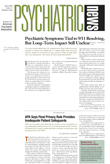APA and its National Partnership for Workplace Mental Health hosted a conference in April on “Disaster, Terror, and Trauma in the Workplace: What Did We Know Before 9/11 and What Have We Learned Since Then?”
The conference, which was funded by the Center for Mental Health Services (CMHS), a component of the Substance Abuse and Mental Health Services Administration, brought together representatives of major corporations, government agencies, private organizations, and experts on the psychiatric issues and mental health needs associated with experiencing disaster.
The report on the conference, which is available on the Web at www.workplacementalhealth.org, includes personal accounts, research findings on conditions such as posttraumatic stress disorder (PTSD), descriptions of the reactions of employers and employees at ground zero, and a discussion about changed attitudes of postal workers toward government as a result of the deaths of their colleagues from anthrax.
Language and Culture Count
APA President-elect Marcia Goin, M.D., who attended the conference, told Psychiatric News that the meeting reinforced the idea that it is critically important to understand and respect the culture of a group when trying to provide help.
“The term ‘debriefing,’ for example, is commonly used in the business world,” she said. “Employees found it much more acceptable to be debriefed about their reactions to the attacks than to submit to an examination intended to uncover evidence of psychiatric problems.”
Neal Cohen, M.D., commissioner of the New York City Department of Mental Health, Mental Retardation, and Alcoholism Services on September 11, described how Mayor Rudolph Giuliani “became a calming and healing presence” for New Yorkers.
The mayor adopted a straightforward communication style and refused to give false assurances to New Yorkers about their safety, according to Cohen.
But Giuliani also highlighted sources of comfort, whenever possible. He provided a “trauma narrative that included recovery,” said Cohen.
At the mayor’s request, Cohen arranged for Giuliani to meet with experts on bereavement and trauma for advice on how to speak about the tragedy publicly and help the city heal.
Prudence Bushnell, now U.S. Ambassador to Guatemala, described her experience in 1998 when the American embassy in Kenya was bombed. She was ambassador to that country at that time.
She said that leaders must recreate normalcy and redirect priorities to allow those who have experienced disaster a sense of competency and success.
Goin said, “Ambassador Bushnell reminded us that a sense of camaraderie and allegiance develops among those who experience an attack. Those who arrive later to help should be sensitive to the idea that they are viewed as outsiders.”
How to Identify PTSD
Carol North, M.D., director of the Psychiatry Consultation Service at Barnes Jewish Hospital in St. Louis and a professor of psychiatry at the Washington University School of Medicine, told the audience that APA has “very precise diagnostic criteria for PTSD.”
According to DSM-IV, the person must be exposed to an “extreme traumatic stressor” that evokes fear, helplessness, or horror.
Five other criteria are described in DSM.
North and her colleagues interviewed 182 survivors of the direct blast of the 1995 Oklahoma City bombing in which 167 people were killed. They found that slightly more than one-third of the people interviewed met the criteria for PTSD. Almost everyone had at least one of the symptoms associated with PTSD, even though they did not all meet the criteria for a psychiatric diagnosis of the disorder.
Symptoms of avoidance and numbing were reported less frequently than other symptoms in the interviews, North found, but if people met the criteria for those symptoms, they almost always met the diagnostic criteria for PTSD, according to the study.
North told the audience that an early and accurate diagnosis is important because, she speculated, people with PTSD “might not do well with therapies that involve having someone relive, share, and talk about the event.”
In contrast, those survivors who did not exhibit signs of avoidance and numbing “may do well with support groups and other settings where they can share their feelings.”
Next Steps
Conference attendee Col. Ann Norwood, associate chair of the department of psychiatry at the Uniformed Services University of the Health Sciences and chair of APA’s Committee on Psychiatric Dimensions of Disasters, told Psychiatric News, “Many of us spend most of our waking hours in the workplace, so the approach of this meeting was very useful.”
She emphasized the importance of using the information gathered as building blocks to develop more specific materials to help employers prepare for and respond to disasters.
APA has developed a brochure that provides definitions and information about stress, disaster, and terrorism. It includes a list of “normal reactions” to disaster such as mood swings, restlessness, and nightmares and also offers a list of reactions that might indicate the need for professional help.
The brochure will be distributed through major corporations and is available by calling the APA Helpline at (800) 35-PSYCH. It also can be accessed on the Web at www.workplacementalhealth.org/resources/APA_brochure_Aug02.pdf. ▪
